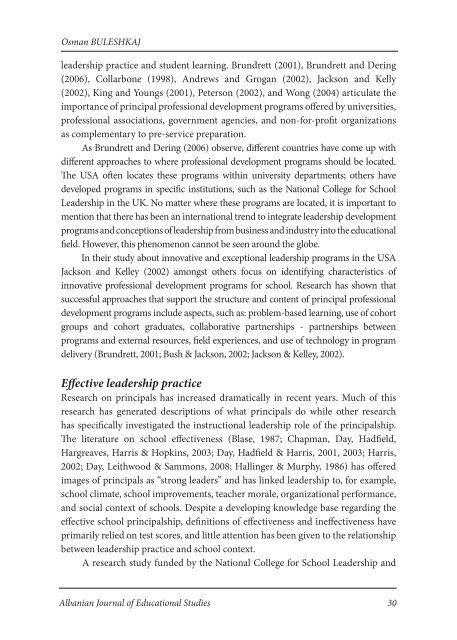Download - qendra per arsim demokratik
Download - qendra per arsim demokratik
Download - qendra per arsim demokratik
You also want an ePaper? Increase the reach of your titles
YUMPU automatically turns print PDFs into web optimized ePapers that Google loves.
Osman BULESHKAJleadership practice and student learning. Brundrett (2001), Brundrett and Dering(2006), Collarbone (1998), Andrews and Grogan (2002), Jackson and Kelly(2002), King and Youngs (2001), Peterson (2002), and Wong (2004) articulate theimportance of principal professional development programs offered by universities,professional associations, government agencies, and non-for-profit organizationsas complementary to pre-service preparation.As Brundrett and Dering (2006) observe, different countries have come up withdifferent approaches to where professional development programs should be located.The USA often locates these programs within university departments; others havedeveloped programs in specific institutions, such as the National College for SchoolLeadership in the UK. No matter where these programs are located, it is important tomention that there has been an international trend to integrate leadership developmentprograms and conceptions of leadership from business and industry into the educationalfield. However, this phenomenon cannot be seen around the globe.In their study about innovative and exceptional leadership programs in the USAJackson and Kelley (2002) amongst others focus on identifying characteristics ofinnovative professional development programs for school. Research has shown thatsuccessful approaches that support the structure and content of principal professionaldevelopment programs include aspects, such as: problem-based learning, use of cohortgroups and cohort graduates, collaborative partnerships - partnerships betweenprograms and external resources, field ex<strong>per</strong>iences, and use of technology in programdelivery (Brundrett, 2001; Bush & Jackson, 2002; Jackson & Kelley, 2002).Effective leadership practiceResearch on principals has increased dramatically in recent years. Much of thisresearch has generated descriptions of what principals do while other researchhas specifically investigated the instructional leadership role of the principalship.The literature on school effectiveness (Blase, 1987; Chapman, Day, Hadfield,Hargreaves, Harris & Hopkins, 2003; Day, Hadfield & Harris, 2001, 2003; Harris,2002; Day, Leithwood & Sammons, 2008; Hallinger & Murphy, 1986) has offeredimages of principals as “strong leaders” and has linked leadership to, for example,school climate, school improvements, teacher morale, organizational <strong>per</strong>formance,and social context of schools. Despite a developing knowledge base regarding theeffective school principalship, definitions of effectiveness and ineffectiveness haveprimarily relied on test scores, and little attention has been given to the relationshipbetween leadership practice and school context.A research study funded by the National College for School Leadership andAlbanian Journal of Educational Studies 30


